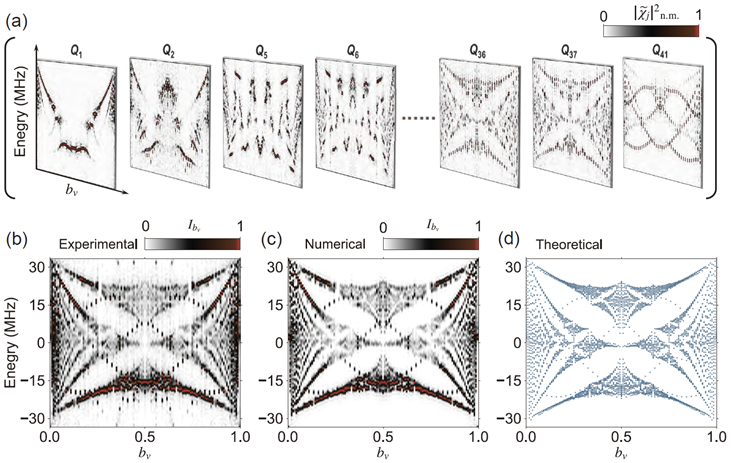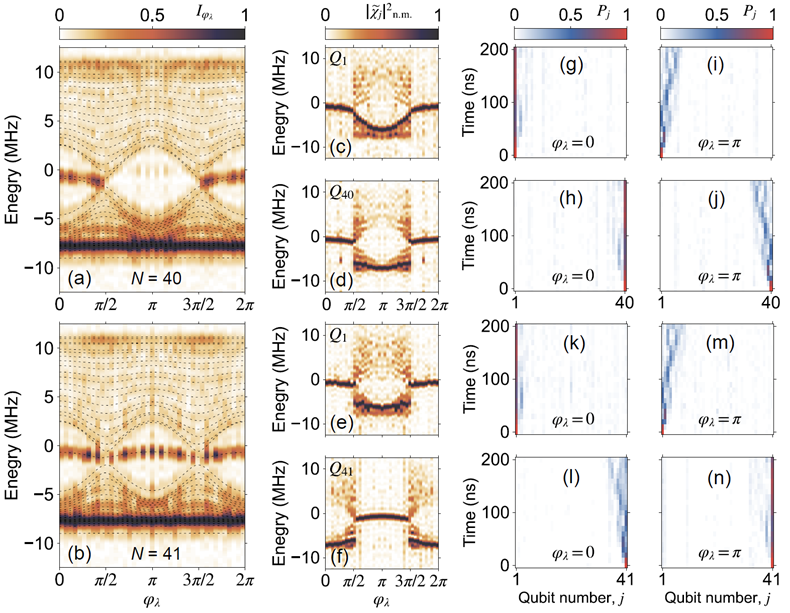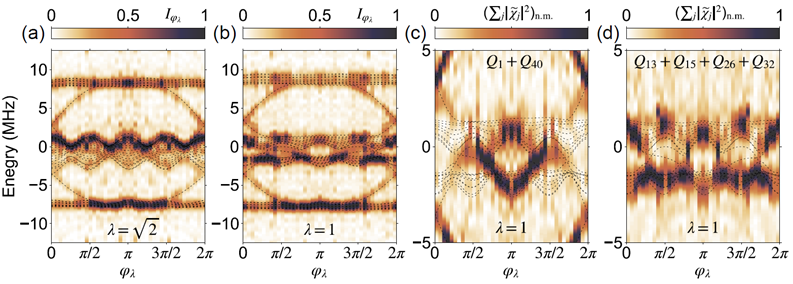Quantum Cloud Group of BAQIS Realized the Quantum Simulation of 41-Qubit Hofstadter Butterfly and Topological Zero Modes on the “Chuang-tzu” Superconducting Quantum Chip
2023/08/30
Recently, the Quantum Cloud group of BAQIS and the Institute of Physics, Chinese Academy of Sciences, developed a one-dimensional superconducting quantum processor, named Chuang-tzu, and used it to simulate the 41-qubit Hofstadter butterfly energy spectrum and various topological zero modes. On Aug 23, 2023, the research results were published in Physical Review Letters under the title "Quantum Simulation of Topological Zero Modes on a 41-Qubit Superconducting Processor".
With the rapid development of superconducting qubit experiment technology and other technical routes, quantum computing has entered the era of NISQ (Noisy Intermediate-Scale Quantum). In this era, superconducting quantum computing seeks to make greater progress in multi-bit integration, long decoherence time, and high control accuracy, and uses high-precision quantum manipulation and independently addressable state readouts to simulate and observe a variety of novel physics that are difficult to achieve in real material systems.
The work begins with the design of various instances of the diagonal Aubry-Andre-Harper (AAH) model of up to 41 qubits and the experimental measurement of the energy spectrum of the famous “Hofstadter butterfly” using dynamic spectroscopy techniques (Figure 2). Due to the topological characteristics of the diagonal AAH model, there is a “wing-like” energy gap, and the entire energy spectrum looks like a dancing butterfly, which is reminiscent of the story of “Chuang Chou Dreaming a Butterfly” in the Warring States period, which is also the origin of the name of this quantum chip. Because the Chuang-tzu processor has enough qubits, the finite-size effects are greatly suppressed, and the fractal structure and band splitting in the details of the butterfly's body are clearly displayed.
Further, the work constructs a non-diagonal AAH model using Floquet engineering (period-driven), directly measures its topological band structure, and witnesses the localization of edge excitation during quantum walking (Figure 3). Using the body-edge correspondence, this work verifies the existence of topological zero-energy edge states in gap-free proportional AAH models, which have never been experimentally observed in previous studies. In addition, because there are more than 40 qubits in the Chuang-tzu quantum chip, this is enough to allow the researchers to capture a large number of topological features of this important one-dimensional quantum many-body system in its complex band structure, including the Dirac points, gap closing, differences between the number of odd-even qubits, and differences between edges and states (Figures 3 and 4). These results also verify the robustness of topological properties in the case of small next-nearest-neighbor interactions. Using a superconducting quantum processor assisted by a highly controllable Floquet regulation technique, this work establishes a general hybrid quantum simulation approach to explore quantum topological systems in the NISQ era.
The work was completed by Prof. Heng Fan, Kai Xu, Dongning Zheng, Zhongcheng Xiang, Shiping Zhao, Ye Tian, Xiaohui Song, Dr. Shi Yunhao and Liu Yu from the Quantum Cloud group of BAQIS/ Institute of Physics, Chinese Academy of Sciences, in collaboration with Prof. Yu-Ran Zhang from South China University of Technology and Prof. Franco Nori from RIKEN. It is supported by the National Natural Science Foundation of China, the Ministry of Science and Technology, the Beijing Natural Science Foundation, and the Chinese Academy of Sciences.
URL: https://journals.aps.org/prl/abstract/10.1103/PhysRevLett.131.080401


Figure 1 Optical micrograph of the 43-qubit Chuang-tzu quantum chip and pulse sequences for diagonal and off-diagonal AAH models.

Figure 2 Hofstadter butterfly energy spectrum.

Figure 3 Experimental characterization of the topological zero-energy edge modes in commensurate off-diagonal AAH models with bλ = 1/2.

Figure 4 Band structure spectroscopy of generic commensurate off-diagonal AAH models with N = 40 and bλ = 1/4.
 中文
中文 Email
Email QCloud
QCloud Log in
Log in
